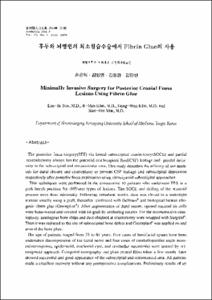후두와 뇌병변의 최소침습수술에서 Fibrin Glue의 사용
- Keimyung Author(s)
- Son, Eun Ik; Kim, El; Kim, Dong Won; Yim, Man Bin
- Department
- Dept. of Neurosurgery (신경외과학)
- Journal Title
- Keimyung Medical Journal
- Issued Date
- 2000
- Volume
- 19
- Issue
- 1
- Keyword
- Suboccipital craniectomy; Dural repair; Cranioplasty; CSF leakage; Fibrin glue; Postoperative headache
- Abstract
- The posterior fossa surgery(PFS) via lateral suboccipital craniectomy(SOCE) and partial mastoidectomy always has the potential cerebrospinal fluid(CSF) leakage and painful deformity in the suboccipital and retroauricular area. This study describes the efficacy of our mathods for dural closure and cranioplasty to prevent CSF leakage and suboccipital depression respectively after posterior fossa exploration using retrosigmoid suboccipital approaches.
This techniques were performed in the consecutive 10 patients who underwent PFS in a park-bench position for different types of lesions. The SOCE and driling of the mastoid process were done minimally. Following intradural works, dura was closed in a watertight manner usually using a graft, thereafter reinforced with GelfoamR and biological human allogenic fibrin glue (GreenplastR). After augmentation of dural suture, opened mastoid air cells were bone-waxed and covered with fat graft by anchoring sutures. For the reconstructive cranioplasty, autologous bone chips and dust obtained at craniectomy were wrapped with SurgicelR. Then it was replaced to the site of suboccipital bone defect and GreenplastR was applied on and around the bone plate.
The age of patients ranged from 33 to 61 years. Five cases of hemifacial spasm have been undertaken decompression of the facial nerve and four cases of cerebellopontine angle masses(meningioma, epidermoid, arachnoid cyst, and cerebellar metastasis) were treated by retrosigmoid approach. Computed tomography and plain cranial films taken a few month later showed successful and good appearance of the suboccipital and retromastoid area. All patients made a excellent recovery without any postoperative complications. Preliminary results of up to 10 months show no CSF leakage nor a persistent headache. There was no adverse reactions related to fibrin glue. We think that the present technique is a valuable method to minimize or avoid postoperative CSF leakage and to restore an autologous bone plate in a cranial defect by piecemal craniectomy.
- Alternative Title
- Minimally Invasive surgery
for Posterior Cranial FossaLesions Using Fibrin Glue
- Publisher
- Keimyung University School of Medicine
- Citation
- 손은익 et al. (2000). 후두와 뇌병변의 최소침습수술에서 Fibrin Glue의 사용. Keimyung Medical Journal, 19(1), 83–90.
- Type
- Article
- Appears in Collections:
- 2. Keimyung Medical Journal (계명의대 학술지) > 2000
1. School of Medicine (의과대학) > Dept. of Neurosurgery (신경외과학)
Items in Repository are protected by copyright, with all rights reserved, unless otherwise indicated.
